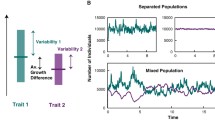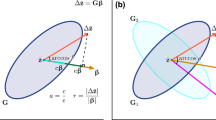Summary
If a phenotypic character is under stabilizing selection, the selective disadvantage of a nonoptimal genotype will decrease exponentially to zero as the proportion of phenotypic variation that is environmental in origin -V e /V p - increases. Under the modified mutation-drift hypothesis of genetic polymorphism, the proportion of mutations that are effectively neutral and average heterozygosity should increase with this ratio. Invertebrates, because of their small size, fast development, and low degree of homeostasis (relative to vertebrates), are expected to show a larger environmental component of phenotypic variation than vertebrates. This may help explain why invertebrates are in general more genetically variable than vertebrates and why, when laboratory populations ofDrosophila are maintained in heterogeneous environments, genetic variability is lost less rapidly than when they are kept in constant conditions.
Similar content being viewed by others
References
Beardmore JA, Levine L (1963) Fitness and environmental variation. 1. A study of some polymorphic populations ofDrosophila pseudoobscura. Evolution 17:121–129
Bonner JT (1965) Size and cycle. Princeton University Press, Princeton, New Jersey
Chakraborty R, Fuerst PA, Nei M (1978) Statistical studies on protein polymorphism in natural populations. II. Gene differentiation between populations. Genetics 88:367–390
Chakraborty R, Fuerst PA, Nei M (1980) Statistical studies on protein polymorphism in natural populations. III. Distribution of allele frequencies and the number of alleles per locus. Genetics 94:1039–1063
Cunha AB da, Dobzhansky T (1954) A further study of chromosomal polymorphism inDrosophila willistoni in its relation to the environment. Evolution 8:119–134
Falconer DS (1960) Introduction to quantitative genetics. Ronald Press Company, New York
Fuerst PA, Chakraborty R, Nei M (1977) Statistical studies on protein polymorphism in natural populations. I. Distribution of single locus heterozygosity. Genetics 86:455–483
Gillespie JH, Langley CH (1974) A general model to account for enzyme variation in natural populations. Genetics 76:837–848
Kimura M (1979) Model of effectively neutral mutations in which selective constraint is incorporated. Proc Natl Acad Sci USA 76:3440–3444
Kimura M (1981) Possibility of extensive neutral evolution under stabilizing selection with special reference to nonrandom usage of synonymous codons. Proc Natl Acad Sci USA 78: 5773–5777
Lacy RC (1982) Niche breadth and abundance as determinants of genetic variation in populations of mycophagous droso-philid flies (Diptera: Drosophilidae). Evolution (in press)
Lande R (1976) The maintenance of genetic variability by mutation in a polygenic character with linked loci. Genet Res Camb 26:221–235
Latter BHD (1970) Selection in finite populations with multiple alleles. II. Centripetal selection, mutation, and isoallelic variation. Genetics 66:165–186
Latter BHD (1975) Influence of selection pressures on enzyme polymorphisms inDrosophila. Nature 257:590–592
Lerner IM (1954) Genetic homeostasis. Oliver and Boyd, Edinburgh
Levene H (1953) Genetic equilibrium when more than one ecological niche is available. Am Natur 87:331–333
Long T (1970) Genetic effects of fluctuating temperature in populations ofDrosophila melanogaster. Genetics 66:401–416
Mackay TFC (1980) Genetic variance, fitness, and homeostasis in varying environments: an experimental check of the theory. Evolution 34:1219–1222
Mackay TFC (1981) Genetic variation in varying environments. Genet Res Camb 37:79–93
McDonald JF, Ayala FJ (1974) Genetic response to environmental heterogeneity. Nature 250:572–574
Nevo E (1978) Genetic variation in natural populations: patterns and theory. Theor Pop Biol 13:121–177
Ohta T (1976) Role of very slightly deleterious mutations in molecular evolution and polymorphism. Theor Pop Biol 10: 254–275
Ohta T (1977) Extension to the neutral mutation random drift hypothesis. In: Kimura M (ed) Molecular evolution and polymorphism, National Institute of Genetics, Mishima, pp 148–167
Pamilo P, Crozier RH (1981) Genic variation in male haploids under deterministic selection. Genetics 98:199–214
Powell JR (1971) Genetic polymorphisms in varied environments. Science 174:1035–1036
Powell JR(1975) Protein variation in natural populations of animals. Evol Biol 8:79–119
Powell JR, Wistrand H (1978) The effect of heterogeneous environments and a competitor on genetic variation inDrosophila. Am Natur 112:935–947
Roughgarden J (1979) Theory of population genetics and evolutionary ecology: an introduction. Macmillan, New York
Schmidt-Nielsen K (1979) Animal physiology. 2nd edition, Cambridge University Press, Cambridge
Selander RK, Kaufman DW (1973) Genic variability and strategies of adaptation in animals. Proc Natl Acad Sci USA 70: 1875–1877
Steiner WWM (1977) Niche width and genetic variation in HawaiianDrosophila. Am Natur 111:1037–1046
Author information
Authors and Affiliations
Rights and permissions
About this article
Cite this article
Jaenike, J. On the relation between genetic and environmental variability in animals. J Mol Evol 18, 310–314 (1982). https://doi.org/10.1007/BF01733897
Received:
Revised:
Issue Date:
DOI: https://doi.org/10.1007/BF01733897




